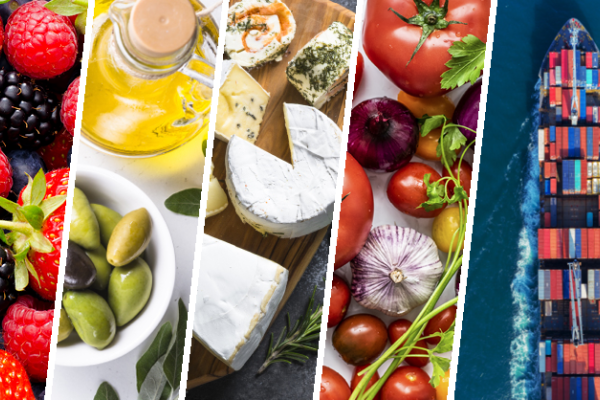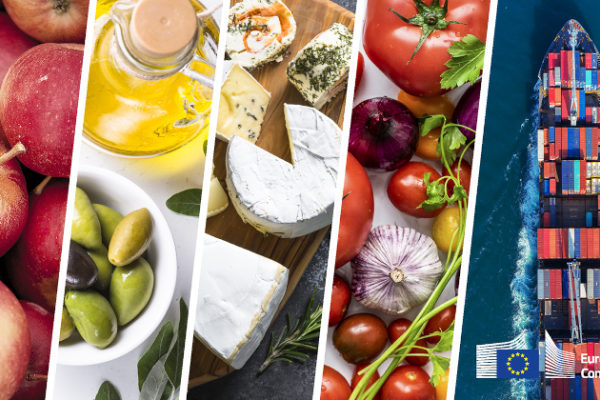United States
The United States is one of the European Union's top partners in agricultural trade.
Negotiations with the US were concluded in February 2019 on reviewing and updating the Memorandum of Understanding between the two partners on imports of high-quality beef.
The United States is a major destination for several high-value EU products, such as:
- wines and spirits
- beer
- chocolate
- cheese
- olive oil
- fruit and vegetable preparations.
The EU is also a key market for a number of major US commodities, such as:
- nuts (almonds walnuts, pistachios)
- soybeans
- animal feed
- wheat
- wines and spirits
- fruit, nuts, and spices.
Amongst the agri-food priorities for the EU in its trading relationship with the US are:
- securing enhanced access to the US market for products such as dairy, processed meat products, sugar confectionery, chocolate and olive oil;
- ensuring a high standard of sanitary and phytosanitary requirements are adhered to;
- protecting geographical indications (GIs) for important EU products.
Agreements with the US currently in force
- 2023: Agreement between the European Union and the United States of America pursuant to Article XXVIII of the General Agreement on Tariffs and Trade (GATT) 1994 relating to the modification of concessions on all the tariff-rate quotas included in the EU
- 2019: Agreement between the United States of America and the European Union on the allocation to the United States of a share in the tariff rate quota for high quality beef from animals not treated with certain growth-promoting hormones
- 2014: Revised Memorandum of Understanding with the United States of America Regarding the Importation of Beef from Animals Not Treated with Certain Growth-Promoting Hormones and Increased Duties Applied by the United States to Certain Products of the European Union
- 2012: Arrangement on the equivalence for organic products
- 2010: Agreement on trade in bananas
- 2006: Agreement on trade in wine
- 2005: Agreement in the form of an Exchange of Letters relating to the method of calculation of applied duties for husked rice
- 2005: Agreement in the form of an Exchange of Letters on matters related to trade in wine
- 2002: Agreement in the form of an Exchange of Letters relating to the modification of concessions with respect to cereals provided for in EC Schedule CXL to the GATT 1994
- 1999: Agreement between the European Community and the United States of America on sanitary measures to protect public and animal health in trade in live animals and animal products
- 1997: Agreement in the form of a Memorandum of Understanding on spirituous beverages
- 1995: Exchange of Letters on a settlement for cereals and rice
- 1992: Agreement in the form of Exchange of Letters concerning the application of the Community directive third countries (Council Directive 72/462/EEC) and of the corresponding regulatory requirements of the United States of America with regard to the bovine and porcine fresh meat trade
Related information
- 13 MAY 2024
Canada
Canada is an important agricultural trade partner for the EU.
The top exported products from the EU to Canada are alcoholic beverages (especially wines, spirits and beer). Other products include chocolate and sugar confectionery, cereal preparations and cheese.
Canada is a major supplier of wheat to the EU. It is also an important supplier of soya beans and oilseeds (such as rapeseed), as well as some fruit and vegetables (including beans, lentils and peas).
In September 2017, the EU-Canada Comprehensive Economic and Trade Agreement (CETA) provisionally entered into force, but still requires ratification from all EU countries. The agreement sets out to cut tariffs and protect GIs for a number of EU agri-food products.
Related information
CETA and agriculture factsheet
- 24 MAY 2024
Mexico
EU agricultural trade with Mexico is balanced slightly in favour of the EU. The EU primarily exports alcoholic beverages (spirits and liqueurs, wines), cereal preparations, gluten and starch, olive oil, tropical fruit, nuts and spices, among others.
From Mexico, the EU imports beer, coffee, alcoholic beverages, fruit juices, leguminous vegetables and citrus fruit, among others.
The EU and Mexico reached an ‘agreement in principle’ on the trade part of a modernised EU-Mexico Global Agreement in April 2018.The new agreement sets out to improve market access for agricultural products for both parties. The agreement also protects 340 EU GIs and 20 Mexican GIs. A robust sanitary and phytosanitary chapter (SPS) was agreed, which safeguards EU standards for food safety, as well as for animal and plant health.
Related information
EU – Mexico agreement in principle
EU – Mexico agreement: factsheet on agriculture
- 25 MAY 2024
The Andean countries
The EU has a comprehensive trade agreement with Colombia and Peru, which has been provisionally applied since 2013. The agreement, joined by Ecuador in 2017, provides benefits for trade in agri-food products. It also provides for the recognition and protection of 116 EU GIs and several GIs from Colombia, Ecuador and Peru.
EU–Andean agricultural trade is balanced in favour of the Andean countries, who supply the EU with:
- bananas (primarily Colombia and Ecuador)
- other fruit
- vegetables
- coffee (primarily Colombia and Peru)
- cocoa beans
- cut flowers (primarily Ecuador and Colombia).
EU exports of agri-food products follow a growing trend since the application of the trade agreement and mainly consist of:
- food preparations
- spirits and liqueurs
- vegetable, fruit and nut preparations
- olive oil
- infant food
- wine.
Related information
Colombia-Peru: Trade Agreement
Agri-food trade statistics
- 24 MAY 2024
- 24 MAY 2024
- 25 MAY 2024
- 25 MAY 2024
- 23 MAY 2024
Central America
Traditionally, trade in agricultural products with the six countries of Central America (Panama, Guatemala, Honduras, Costa Rica, El Salvador and Nicaragua) has focused on coffee and banana imports into the EU.
In June 2012, the EU and the Central American region signed a new Association Agreement, providing both sides with increased market access for agricultural goods.
The agreement provided benefits for the EU’s wine and spirits sector, as well as for dairy and meat exports. The agreement also established the concept of GIs in the domestic legislation of all six countries, reinforcing the position of EU quality products in these markets.
For the Central American countries, the agreement consolidated the GSP+ (General System of Preferences 'plus') regime of trade concessions, and added tariff rate quotas on products such as sugar and rum. Banana exports from the region will also benefit from a gradually lowering preferential tariff, reaching a limit of 75 EUR per tonne in 2020.
The main EU imports from Central America are:
- tropical fruit
- nuts and spices
- coffee
- tea
- palm and palm kernel oils
- vegetable products
- bulbs, roots, and live plants.
The main EU exports to Central America are:
- spirits and liqueurs
- infant food
- preparations of vegetables, fruits and nuts
- malt
- wine, vermouth, cider and vinegar.
Related information
Full text and annexes of the agreement
EU-Central America Association Agreement
Agri-food trade statistics
- 24 MAY 2024
- 25 MAY 2024
- 25 MAY 2024
- 25 MAY 2024
- 25 MAY 2024
- 23 MAY 2024
Chile
The EU-Chile Association Agreement currently governs the agri-food trade between the EU and Chile. It was concluded in 2002 and entered into force in February 2003.
Once finalised, the modernised Interim Free Trade Agreement (iFTA) and the Advanced Framework Agreement (AFA) will replace the EU-Chile Association Agreement. It is currently in the process of ratification by Chile and the EU. The Council of the European Union approved the Agreements on 4 December 2023, and the iFTA and AFA were signed by both partners on 13 December 2023.
Chile is traditionally a minor destination for EU agricultural exports, but a significant supplier of agricultural imports to the EU, notably for fruits and nuts as well as wine.
Chile supplies the EU with a wide variety of products, including:
- vegetables and vegetable preparations
- fruit, in particular grapes, apples and pears
- tropical fruits, nuts and spices
- wines
- vermouth, cider, and vinegar
- nuts
- fruit juices.
Amongst the main products exported by the EU to Chile are:
- beer
- food preparations
- fruit and vegetable preparations
- spirits and liqueurs
- cheese
- pasta, pastry, biscuits and bread
- animal feedstuffs.
Once the modernised Agreements will enter into force, they will further gradually open the Chiliean market for agricultural products, such as cereals, cheese, dairy and vegetable oils. Chile will ultimately fully liberalise all EU dairy products and food preparations.
The modernised Agreements (iFTA and AFA) will also protect the 216 most relevant Geographical Indications (GIs) of agri-food items coming from a broad variety of EU Member States to the Chilean market. This comes on top of the 1 573 wines and 235 spirit drinks and aromatised wines from the EU, which are already protected under the current Agreement.
Related information
The modernised EU-Chile Advanced Framework Agreement
Mercosur countries
Mercosur countries (Brazil, Argentina, Uruguay, Paraguay; Venezuela*) are major suppliers of agricultural products to the EU.
The top product categories imported from Mercosur countries include:
- oilcakes
- soya beans
- coffee
- tea
- bovine meat
- fruit juices.
Argentina is a top supplier of bovine meat, while Brazil is a leading provider of poultry meat, sugar (mainly raw cane sugar), and ethanol.
The main exports from the EU to the Mercusor countries are:
- olive oil
- spirits and liqueurs
- vegetable preparations
- wine and vermouth
- cider and vinegar.
In 2019, the EU concluded an agreement in principle with the four founding member countries of Mercosur (Argentina, Brazil, Paraguay and Uruguay), removing high tariffs for the main EU export products, preventing imitation of EU traditional foodstuffs, and making food safety procedures easier to follow for EU exporters.
*Venezuela's Mercosur membership is currently suspended
Related information
Inter-regional Framework Cooperation Agreement
EU-Mercosur trade agreement: factsheet on agriculture
Agri-food trade statistics
- 24 MAY 2024
- 24 MAY 2024
- 13 MAY 2024
- 25 MAY 2024
- 13 MAY 2024
- 24 MAY 2024


